
The Noctuidae, commonly known as owlet moths, cutworms or armyworms, are the most controversial family in the superfamily Noctuoidea because many of the clades are constantly changing, along with the other families of the Noctuoidea. It was considered the largest family in Lepidoptera for a long time, but after regrouping Lymantriinae, Catocalinae and Calpinae within the family Erebidae, the latter holds this title now. Currently, Noctuidae is the second largest family in Noctuoidea, with about 1,089 genera and 11,772 species. However, this classification is still contingent, as more changes continue to appear between Noctuidae and Erebidae.

Agrotis segetum, sometimes known as the turnip moth, is a moth of the family Noctuidae. The species was first described by Michael Denis and Ignaz Schiffermüller in 1775. It is a common European species and it is found in Africa and across Eurasia except for the northernmost parts.

The heart and dart is a moth of the family Noctuidae. The species was first described by Carl Linnaeus in his 1758 10th edition of Systema Naturae. A familiar moth to many, it is considered one of the most common of the European region. It occurs throughout the Palearctic realm from Ireland to Japan.
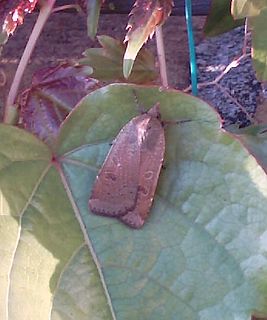
The lesser yellow underwing is a moth of the family Noctuidae.

The setaceous Hebrew character is a moth of the family Noctuidae. The species was first described by Carl Linnaeus in his 1758 10th edition of Systema Naturae. It is found in the Palearctic realm. It is a common species throughout Europe and North Asia and Central Asia, South Asia, China, Japan and Korea. It is also found in North America, from coast to coast across Canada and the northern United States to western Alaska. It occurs in the Rocky Mountains from Montana to southern Arizona and New Mexico. In the east, it ranges from Maine to North Carolina. It has recently been recorded in Tennessee.

Agrotis ipsilon, the dark sword-grass, black cutworm, greasy cutworm, floodplain cutworm or ipsilon dart, is a small noctuid moth found worldwide. The moth gets its scientific name from black markings on its forewings shaped like the letter "Y" or the Greek letter upsilon. The larvae are known as "cutworms" because they cut plants and other crops. The larvae are serious agricultural pests and feed on nearly all varieties of vegetables and many important grains.

Peridroma saucia, the pearly underwing or variegated cutworm, is a species of moth of the family Noctuidae. The species was first described by Jacob Hübner in 1808. It is found in North and South America, Europe, Asia and Africa. The variegated cutworm feeds on many plants, especially common fruits and vegetables. The moth undergoes two to four generations per year. The development of the moth slows in colder temperatures, indicative of its migratory nature. All stages of the life cycle have a developmental threshold for temperature. The moth is known to migrate to the northern regions during warmer months, returning to the southern regions when the climate becomes colder.

Actebia is a genus of moths of the family Noctuidae.
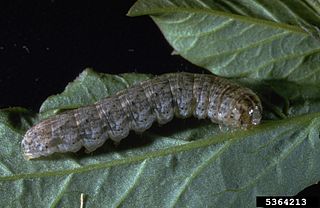
Euxoa messoria, the darksided cutworm or reaper dart, is a moth of the family Noctuidae. The species was first described by Thaddeus William Harris in 1841. It is found from Newfoundland west to Yukon, south to Virginia and Missouri in the east and New Mexico, Arizona and California in the west.

Xestia badicollis, the northern variable dart, northern conifer dart or white pine cutworm when referring to the larval stage, is a moth of the family Noctuidae. The species was first described by Augustus Radcliffe Grote in 1873. It is found in North America from Nova Scotia to North Carolina, west to Missouri and Ontario.

Abagrotis alternata, the greater red dart or mottled gray cutworm, is a moth of the family Noctuidae. The species was first described by Augustus Radcliffe Grote in 1865. It is found in eastern North America, from New Brunswick west across southern Canada to western Alberta, south to Arizona, New Mexico and the Gulf of Mexico.
Abagrotis orbis, the well-marked cutworm or Barnes' climbing cutworm, is a moth of the family Noctuidae. It is in southwestern North America, extending eastward across the plains and with a large disjunct population in dune habitats in the southern Great Lakes area. It extends into western Canada only in the southern interior of British Columbia and southern Alberta and Saskatchewan.

Actebia praecox, the Portland moth, is a moth of the family Noctuidae. The species was first described by Carl Linnaeus in his 1758 10th edition of Systema Naturae. It is found in northern and central Europe, the Caucasus, central Asia, Siberia, Kamchatka, Sakhalin, the Kuriles, northern Turkey, Mongolia, China, Korea and Japan.
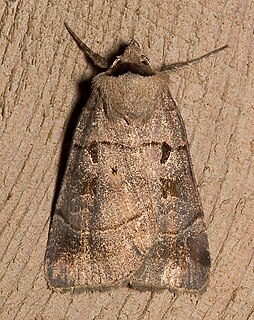
Agnorisma badinodis is a moth of the family Noctuidae. It is found in southern Canada and United States, east of the 100th meridian, and exclusive of the Deep South.
Amphipoea interoceanica, the interoceanic ear moth, strawberry cutworm moth or strawberry cutworm, is a moth of the family Noctuidae first described by Smith in 1899. It is found from coast to coast in the United States. In Canada from Quebec west to Alberta, Nova Scotia.

Apamea zeta is a moth of the family Noctuidae. It has a Holarctic distribution, and can be found throughout the Northern Hemisphere. It occurs throughout Europe and the northern half of North America.
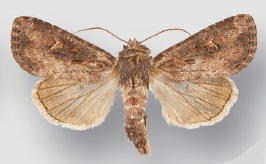
Resapamea passer, the dock rustic moth, is a moth in the family Noctuidae. It is found from central Alberta to northern Arizona in the Rocky Mountain region. In the mid-Continent it ranges from Minnesota and southern Ontario to Oklahoma and North Carolina, reaching the Atlantic Coast from Newfoundland to Maryland. The habitat consists of wetlands.

Pseudeustrotia carneola, the pink-barred lithacodia moth, is a moth of the family Noctuidae. It is found in North America, where it has been recorded from Nova Scotia and New Brunswick west to Alberta and Colorado, south to the Gulf of Mexico. The habitat consists of woodland edges, mesic meadows and grasslands regions.
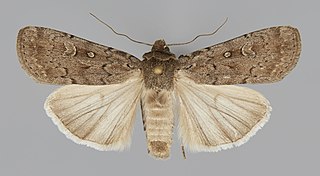
Actebia balanitis is a moth of the family Noctuidae. It is found from north-east Alaska and western Yukon east to east central Saskatchewan and north central South Dakota, south to northern Colorado and west to central Washington and the dry interior of British Columbia. The wingspan is 36–40 mm. Adults are on wing from June to August depending on the location. There is one generation per year.
Macronoctua onusta, the iris borer, is a species of cutworm or dart moth in the family Noctuidae. It is found in North America.

















